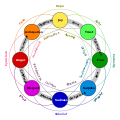Emotion work
Emotion work is a sociological concept that refers the effort of trying to change in degree or quality an emotion or feeling; it's the work of changing your feelings or displaying feelings that you don't feel.[1]
Emotion work includes suppressing strong emotions that you feel, and evoking or producing feelings that you do not feel. Emotion work may extend beyond management of one's own feelings to work done in an effort to maintain a relationship;[2] there is dispute as to whether emotion work is only work done regulating one’s own emotion, or extends to performing the emotional work for others.[3]
Hochschild
Arlie Russell Hochschild, who introduced the term in 1979, distinguished emotion work – unpaid emotional work that a person undertakes in private life – from emotional labor: emotional work done in a paid work setting.[1][4] Emotion work occurs when people attempt to change their emotions or their emotional display for their own non-compensated benefit (e.g., in their interactions with family and friends). By contrast, emotional labor has exchange value because it is traded and performed for a wage.[5]
In a later development, Hochschild distinguished between two broad types of emotion work, and among three techniques of emotion work.[6] The two broad types involve evocation and suppression of emotion, while the three techniques of emotion work that Hochschild describes are cognitive, bodily and expressive.[6][7]
However, the concept (if not the term) has been traced back as far as Aristotle: as Aristotle saw, the problem is not with emotionality, but with the appropriateness of emotion and its expression.[8]
Examples
Examples of emotion work include when you actively work to try to seem indifferent or neutral, when you actually have very strong feelings. You might also feign interest in a conversation when you're actually feeling bored or uninterested. If someone just broke up with you, and you still love them, it takes a great deal of emotion work to convince yourself that you no longer love them or want to be with them. This effort of trying to change your emotions, to like someone less, or to begin to see someone only as a friend when you feel strong romantic feelings for them is an example of emotion work.
Emotion work also involves the orientation of self/others to accord with accepted
Cultural norms often imply that emotion work is reserved for females.[11] There is certainly evidence to the effect that the emotional management that women and men do is asymmetric;[12] and that in general, women come into a marriage groomed for the role of emotional manager.[13]
Criticism
The social theorist Victor Jeleniewski Seidler argues that women's emotion work is merely another demonstration of false consciousness under patriarchy, and that emotion work, as a concept, has been adopted, adapted or criticized to such an extent that it is in danger of becoming a "catch-all-cliché".[14]
More broadly, the concept of emotion work has itself been criticized as a wide over-simplification of mental processes such as
Literary analogues
See also
- Hazing
- Bullying
- Affect display
- Peer pressure
- Toxic positivity
- Emotional labor
- Toxic workplace
- Cognitive dissonance
- Occupational burnout
- Fake it till you make it
- Emotional intelligence
- Emotional detachment
- Workplace harassment
- Emotional self-regulation
- Dissociation (psychology)
- Afterburn (psychotherapy)
- Marx's theory of alienation
- Face (sociological concept)
References
- ^
- ^ Cook, Alicia; Berger, Peggy (April 2000). "Predictors of emotion work and household labor among dual-earner couples". cyfernet.org. CYFAR Program, University of Minnesota. Archived from the original on 1 May 2009. Retrieved 10 October 2010.
- ISBN 9780520063921.
- ISBN 978-0-7914-0269-6.
- ISBN 978-0-7656-0937-3.
- ^ ISBN 9780585092379. Preview.
- ISBN 9780387307152.
- ISBN 9780553375060.
- ISBN 9789042032415.
- ISBN 9789042032415.
- ISBN 9780195149753.
- ^ Oliker (1989), "Women friends and marriage work", in Oliker (ed.), Best friends and marriage: exchange among women, p. 144.
- ^ Goleman (1995), "Intimate enemies", in Goleman (ed.), Emotional intelligence, p. 132.
- ^ ISBN 9780203437452
- ^ Ferrara (1993), "Beyond the limits of autonomy Rousseau's ethic of authenticity: B The limits of autonomy", in Ferrara (ed.), Modernity and authenticity: a study in the social and ethical thought of Jean-Jacques Rousseau, p. 104.
Further reading
- ISBN 9780520054547.


